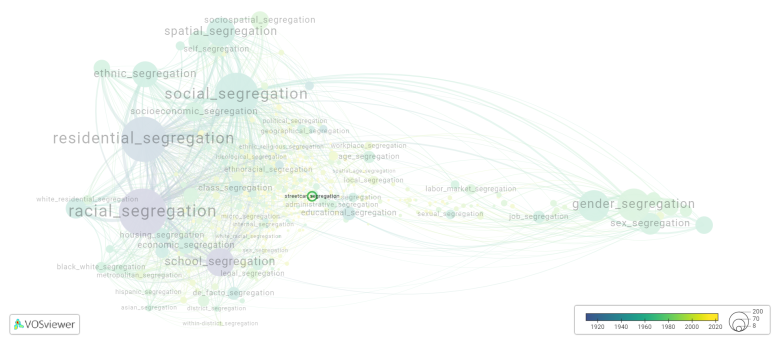Streetcar segregation: Difference between revisions
(Creating page) |
(Creating page) |
||
| (4 intermediate revisions by the same user not shown) | |||
| Line 13: | Line 13: | ||
The end of streetcar segregation marked a significant milestone in the struggle for racial equality and civil rights in the United States. Today, streetcars and public transportation in general are no longer segregated, and laws prohibit discrimination based on race, although issues of equity and access still persist. | The end of streetcar segregation marked a significant milestone in the struggle for racial equality and civil rights in the United States. Today, streetcars and public transportation in general are no longer segregated, and laws prohibit discrimination based on race, although issues of equity and access still persist. | ||
==== | ==See also== | ||
==Related segregation forms== | |||
Streetcar segregation is frequently discussed in the literature with the following segregation forms: | |||
[[public segregation]] | |||
[[File:streetcar_segregation.png|780x780px]] | |||
This visualization is based on the study [[Segregation_Wiki:About| The Multidisciplinary Landscape of Segregation Research]]. | |||
For the complete network of interrelated segregation forms, please refer to: | |||
* [https://tinyurl.com/2235lkhw First year of publication] | |||
* [https://tinyurl.com/2d8wg5n3 Louvain clusters] | |||
* [https://tinyurl.com/223udk5r Betweenness centrality] | |||
* [https://tinyurl.com/244d8unz Disciplines in which segregation forms first emerged (Scopus database).] | |||
==References== | ==References== | ||
==Notes== | ==Notes== | ||
<references /> | <references /> | ||
{{NoteAI}} | {{NoteAI}} | ||
==Streetcar | ==Streetcar segregation appears in the following literature== | ||
Roback J. (1986 | Roback J. (1986). The Political Economy of Segregation: The Case of Segregated Streetcars. ''The Journal of Economic History'', ''46''(4), 893-917. https://doi.org/10.1017/S0022050700050634 | ||
Latest revision as of 07:17, 16 October 2024
Date and country of first publication[1][edit | edit source]
1986
United States
Definition[edit | edit source]
Streetcar segregation refers to the discriminatory practice of segregating passengers on streetcars based on their race or ethnicity. This was prevalent in many cities in the United States during the late 19th and early 20th centuries, particularly in the southern states.
In the era of Jim Crow laws and racial segregation, African Americans were often forced to sit in designated sections at the back of streetcars or were even completely prohibited from using public transportation. This practice aimed to reinforce racial hierarchy and maintain white supremacy.
These segregated streetcars were a symbol of the broader system of segregation that existed in many aspects of society, including education, housing, and public facilities. The Supreme Court's ruling in the Plessy v. Ferguson case in 1896 upheld the constitutionality of segregation, including on streetcars, as long as the separate facilities were considered "equal."
The fight against streetcar segregation became an important part of the larger civil rights movement in the mid-20th century. Activists and organizations, such as the NAACP, launched legal challenges and grassroots campaigns to end this discriminatory practice. The most famous case was the 1955 Montgomery Bus Boycott, triggered by Rosa Parks' refusal to give up her seat on a city bus, which ultimately led to the desegregation of public transportation in the United States.
The end of streetcar segregation marked a significant milestone in the struggle for racial equality and civil rights in the United States. Today, streetcars and public transportation in general are no longer segregated, and laws prohibit discrimination based on race, although issues of equity and access still persist.
See also[edit | edit source]
Related segregation forms[edit | edit source]
Streetcar segregation is frequently discussed in the literature with the following segregation forms:
This visualization is based on the study The Multidisciplinary Landscape of Segregation Research.
For the complete network of interrelated segregation forms, please refer to:
References[edit | edit source]
Notes[edit | edit source]
- ↑ Date and country of first publication as informed by the Scopus database (December 2023).
At its current state, this definition has been generated by a Large Language Model (LLM) so far without review by an independent researcher or a member of the curating team of segregation experts that keep the Segregation Wiki online. While we strive for accuracy, we cannot guarantee its reliability, completeness and timeliness. Please use this content with caution and verify information as needed. Also, feel free to improve on the definition as you see fit, including the use of references and other informational resources. We value your input in enhancing the quality and accuracy of the definitions of segregation forms collectively offered in the Segregation Wiki ©.
Streetcar segregation appears in the following literature[edit | edit source]
Roback J. (1986). The Political Economy of Segregation: The Case of Segregated Streetcars. The Journal of Economic History, 46(4), 893-917. https://doi.org/10.1017/S0022050700050634

